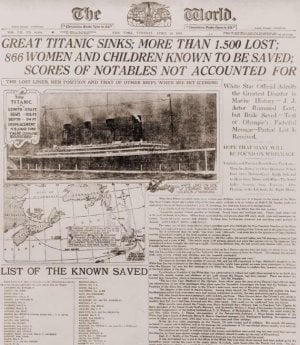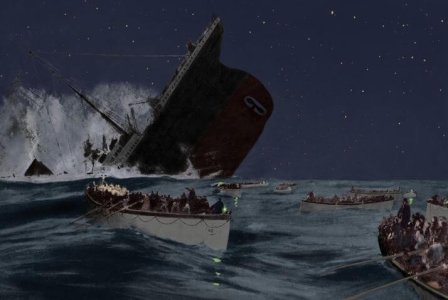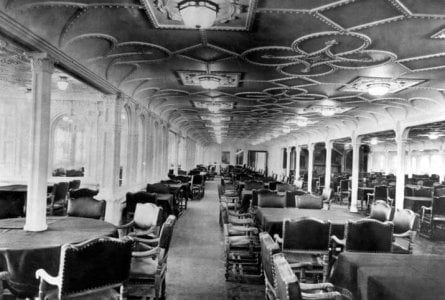Uncovering The Titanic's Final Secrets: Inside the Haunting Mission to the Wreckage
- Replies 6
More than a century after the maiden voyage of the RMS Titanic, the human stories and tragedies associated with the sinking of the unsinkable vessel continue to mesmerise the world. Movies, documentaries and books have retold the stories of those on board, their heroic acts of bravery, their untimely ends, or their survival story.
For Robert Ballard, a researcher from the Woods Hole Oceanographic Institution (WHOI), his curiosity runs much deeper than what we can see from the surface.
According to Mr Ballard, the sheer size of the vessel and the shoes that were left on board were what struck him the most when he descended to the wreckage of the RMS Titanic in 1986.
This was also the year after he and his crew from the Woods Hole Oceanographic Institution (WHOI) helped find the vessel that struck an iceberg and sank in the North Atlantic Ocean in 1912.
‘The first thing I saw coming out of the gloom at 30 feet was this wall, this giant wall of riveted steel that rose over 100 and some feet (30 or so metres) above us,’ he told reporters on the same day the WHOI released 80 minutes of never-before-seen underwater video of the expedition to the wreckage.
‘I never looked down at the Titanic. I looked up at the Titanic. Nothing was small,’ he shared.
Mr Ballad recalled that the three-person submersible he was in headed to the surface when it started taking water into its batteries. As it rose, he claimed he saw the Titanic’s portholes.
‘It was like people looking back at us. It was pretty haunting actually,’ he shared.
The researcher explained that although there was no human flesh or bone left, he saw the footwear of what appeared to be a mother and child. He said these looked like tombstones marking the spot where over 1,500 people lost their lives and came to rest on the ocean floor.
‘After the Titanic sank, those that went into the water that didn’t have life jackets died of hypothermia and their bodies came raining down,’ Mr Ballard declared.
The ship sank as it made its way from Southampton, England to New York City after hitting an iceberg in the early hours of April 15, 1912.
The WHOI team, in partnership with Institut français de recherche pour l'exploitation de la mer (IFREMER) which is a French oceanographic exploration organisation, discovered the wreckage i3,780 metres under water on September 1, 1985. The researchers only used a towed underwater camera to capture evidence.
But the newly released footage that was made public recently was from a return expedition the following year.
According to WHOI engineer Andy Bowen, both the 1985 discovery and 1986 trip were made possible due to the underwater vehicles that could withstand the unforgiving conditions.
‘The water is near freezing temperatures and probably the biggest challenge is the remoteness of the location, and in particular the harsh environment with regard to the pressure our equipment is exposed to,’ Mr Bowen explained.
Mr Ballard said he went through a rollercoaster of emotions during the 1985 mission. That was because he was concerned that the public would figure out that he was a Naval intelligence officer who was on a top-secret Cold War mission at the time.
The mission, funded by the US Navy, included studying the wreck of two nuclear submarines that had also gone down in the North Atlantic.
The search for the Titanic was an afterthought.
‘I was heavily involved in my military program. So, I wasn’t expecting to be affected by the discovery,’ he admitted.
The Titanic sank at about 2:20 am. The 1985 discovery using the underwater camera occurred at around 2 am. Talk about destiny, amirite?
Upon seeing the wreckage, Mr Ballad recalled one of the crew members glancing at the clock and saying: ‘She sinks in 20 minutes.’
‘We actually stopped the operation and raised the vehicle to gather my thoughts and I said, “I’m going to go outside and just get myself back together” and everyone else followed,’ he stated before adding that they had a small memorial service for the people who lost their lives.
‘It was hallowed ground,’ Mr Ballard shared.
You can watch some of the survivors’ stories below:
Footage of the expedition was released in conjunction with the 25th anniversary release of the Academy Award-winning movie Titanic.
Director James Cameron released a statement regarding the release of the new footage. He said: ‘More than a century after the loss of Titanic, the human stories embodied in the great ship continue to resonate.’
‘By releasing this footage, WHOI is helping tell an important part of a story that spans generations and circles the globe,’ he continued.
 If you too are captivated by the tale of the Titanic and want to discover more of its secrets, you can find the 80 minutes of underwater video and other footage released by the WHOI here.
If you too are captivated by the tale of the Titanic and want to discover more of its secrets, you can find the 80 minutes of underwater video and other footage released by the WHOI here.
So what do you think, members? Do you find these kinds of stories fascinating?
For Robert Ballard, a researcher from the Woods Hole Oceanographic Institution (WHOI), his curiosity runs much deeper than what we can see from the surface.
According to Mr Ballard, the sheer size of the vessel and the shoes that were left on board were what struck him the most when he descended to the wreckage of the RMS Titanic in 1986.
This was also the year after he and his crew from the Woods Hole Oceanographic Institution (WHOI) helped find the vessel that struck an iceberg and sank in the North Atlantic Ocean in 1912.
‘The first thing I saw coming out of the gloom at 30 feet was this wall, this giant wall of riveted steel that rose over 100 and some feet (30 or so metres) above us,’ he told reporters on the same day the WHOI released 80 minutes of never-before-seen underwater video of the expedition to the wreckage.
‘I never looked down at the Titanic. I looked up at the Titanic. Nothing was small,’ he shared.
Mr Ballad recalled that the three-person submersible he was in headed to the surface when it started taking water into its batteries. As it rose, he claimed he saw the Titanic’s portholes.
‘It was like people looking back at us. It was pretty haunting actually,’ he shared.
The researcher explained that although there was no human flesh or bone left, he saw the footwear of what appeared to be a mother and child. He said these looked like tombstones marking the spot where over 1,500 people lost their lives and came to rest on the ocean floor.
‘After the Titanic sank, those that went into the water that didn’t have life jackets died of hypothermia and their bodies came raining down,’ Mr Ballard declared.
The ship sank as it made its way from Southampton, England to New York City after hitting an iceberg in the early hours of April 15, 1912.
The WHOI team, in partnership with Institut français de recherche pour l'exploitation de la mer (IFREMER) which is a French oceanographic exploration organisation, discovered the wreckage i3,780 metres under water on September 1, 1985. The researchers only used a towed underwater camera to capture evidence.
But the newly released footage that was made public recently was from a return expedition the following year.
According to WHOI engineer Andy Bowen, both the 1985 discovery and 1986 trip were made possible due to the underwater vehicles that could withstand the unforgiving conditions.
‘The water is near freezing temperatures and probably the biggest challenge is the remoteness of the location, and in particular the harsh environment with regard to the pressure our equipment is exposed to,’ Mr Bowen explained.
Mr Ballard said he went through a rollercoaster of emotions during the 1985 mission. That was because he was concerned that the public would figure out that he was a Naval intelligence officer who was on a top-secret Cold War mission at the time.
The mission, funded by the US Navy, included studying the wreck of two nuclear submarines that had also gone down in the North Atlantic.
The search for the Titanic was an afterthought.
‘I was heavily involved in my military program. So, I wasn’t expecting to be affected by the discovery,’ he admitted.
The Titanic sank at about 2:20 am. The 1985 discovery using the underwater camera occurred at around 2 am. Talk about destiny, amirite?
Upon seeing the wreckage, Mr Ballad recalled one of the crew members glancing at the clock and saying: ‘She sinks in 20 minutes.’
‘We actually stopped the operation and raised the vehicle to gather my thoughts and I said, “I’m going to go outside and just get myself back together” and everyone else followed,’ he stated before adding that they had a small memorial service for the people who lost their lives.
‘It was hallowed ground,’ Mr Ballard shared.
You can watch some of the survivors’ stories below:
Footage of the expedition was released in conjunction with the 25th anniversary release of the Academy Award-winning movie Titanic.
Director James Cameron released a statement regarding the release of the new footage. He said: ‘More than a century after the loss of Titanic, the human stories embodied in the great ship continue to resonate.’
‘By releasing this footage, WHOI is helping tell an important part of a story that spans generations and circles the globe,’ he continued.
Key Takeaways
- Robert Ballard was part of the Woods Hole Oceanographic Institution crew that found the wreckage of the RMS Titanic in 1985.
- He recalled seeing the sheer size of the vessel and shoes marking locations where people lost their lives.
- The 1985 discovery and 1986 expedition was made possible by sophisticated underwater vehicles developed by the team.
- The release of footage accompanies the 25th anniversary release of the remastered version of the movie Titanic.
So what do you think, members? Do you find these kinds of stories fascinating?











